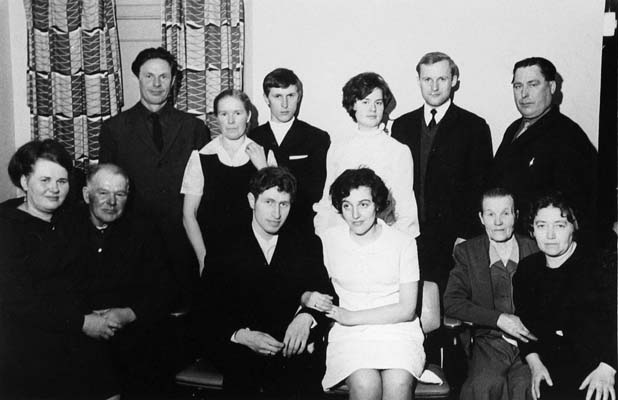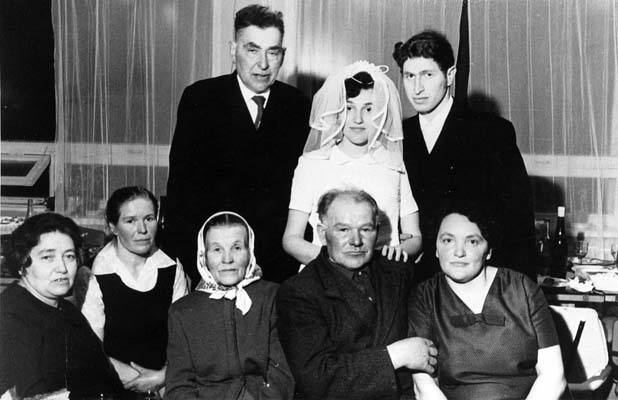

Project «Voices of Jewish settlements. Vitebsk region.»פיתוח קשרי התרבות בין העמים של ישראל ובלרוס
|
|---|
Website search |
|
MainNew publicationsContactsSite mapVitebsk regionMogilev regionMinsk regionArkady Shulman
|
THE RIGHTEOUS MENThe village of Ikazn (now Braslav region) was a part of Poland before the war. It used to be a multinational village with Poles, Belarusians, Russians and Jews. The Red Army came here on September 17th, 1939 and the local people were wary of the new authority. Then there were first deportations, which took place at night and in the morning the neighbors found the houses deserted. There were no rich Jewish families in Ikazn and therefore Jews were not deported. On June 24th, 1941 the German Army passed through Ikazn. Soon those residents, who were not happy with the Soviet repressions, anti-Semites and different criminals, became policemen. The local Jews were in the Miory ghetto, 20 km away from the village. Izik Samovar was among them.  Upper row: Deviatko Faost (Zhorova Olimpiada’s husband), Zhorova (Deviatko) Olimpiada,
Upper row: Deviatko Faost (Zhorova Olimpiada’s husband), Zhorova (Deviatko) Olimpiada,Denisov Nikolai, Denisova Svetlana, Denisov Nikolai, Denisov Leonid (Zhorovs’ nephew) Bottom row: Denisova Nina (Denisov Leonid’s wife), Zhorov Arseny, Meyerov Aizik, Samovar (Meyerova) Sofia, Zhorova Marfa, Kraizelman Tsyva. As a child, Izik Nakhmanovich Samovar (1911-1990) went to a heder and also finished six grades in a Polish school. When he grew up he rented the local lake together with his “friend”. They earned their living by selling the fish they caught in the lake. Izik used to be a good swimmer, which was of great use later. His sister Dveira had many skills: she knitted pretty scarves, pullovers and gloves and was an excellent cook. She made a nice looking scarf for her brother’s “friend”, too. Initially, the ghetto in Miory was more or less open: Jews were allowed to leave and look for food. Anyway, they had nowhere to hide with the yellow stars on their clothes. The humiliations, however, were not different from the rest of the ghettos. Izik’s sister Dveira was one day trampled by his “friend’s” boots, the one who Izik went fishing with and for whom she made the scarf to keep him warm. In the summer of 1942 the poor people realized that it was the time for “the final solution” to the Jewish issue. And people started fleeing. Ize-Mendel Makutonin and his sister managed to get out and hid behind a cow herd. Then they reached the closest forest. Izik Samovar also managed to get out of the ghetto. According a story, told by his daughter, her father was taken to the execution together with the rest of the Jews. But a miracle happened, and he fell into the grave a second earlier than the shooting started and then crawled out from the pile of the dead bodies. Some time later Izik Samovar was sheltered by Marfa Zhorova. He had been familiar with Marfa Zhorova before the war but they had not been close friends. She had two children: Lipa (Olimpiada), aged 17 and Ignat, aged 15. Marfa’s sister, Anna Denisova, had 7 children and was also hiding a Jewish family – the Genses, which consisted of 7 people. Of course, the sisters’ husbands – Gavrila Denisov and Arsen Zhorov and their children helped to conceal the Jews. Naturally, they were scared. They dug a hole in the ground on their field and hid them there. The shelter got extremely cold in winter. In winter Ignat Zhorov and Lenia Denisov (Anna’s son) went to the forest and brought food to the hole. At night they came into the families’ houses.  Upper row: Samovar Izik, Samovar (Meyerova) Sofia, Meyerov Aizik.
Upper row: Samovar Izik, Samovar (Meyerova) Sofia, Meyerov Aizik.Bottom row from left to right: Kraizelman Tsylia, Zhorova (Deviatko) Olimpiada, Zhorova Marfa, Zhorov Arseny, Deich Sima. Once, it was in the evening, the Zhorovs were visited by a policeman. At that time there were several people in the house who came to warm themselves up. Marfa Zhorova did not panic: she gave him some vodka and sang so that he might not hear the breathing of the people. So they spent the evening. Staying at their house was becoming dangerous and Lenia Denisov went to the forest every day trying to find partisans. The policemen, however, felt something was wrong. One day they came to the house and said that the owners had to move to Druya. The Jews were at that time in the bathhouse. Marpha started shouting: “Neighbors, neighbors, we have to leave. Please look after our cattle.” Of course, the Jews understood and quickly vanished in the woods. Izik Samovar stayed with the Zhorovs for ten months. Eventually he had to leave and hid himself in the woods. Once he was captured and had to face an execution. People saw him being convoyed in his underwear. Perhaps he had been found sleeping somewhere. When Nazis were preparing the execution, he dashed out of the pit he had been taken to and disappeared. The white morning fog, his white underwear, the white snow and God saved him on that frosty morning. Then followed the years of starvation, loneliness, wandering and eternal fear… He spent nights in hay stacks, at his acquaintances’, nowhere more than a night. In 1943 Izik Samovar found and joined a partisan brigade. In 1944 he joined the Red Army and always went to the most dangerous battles. He wished to revenge Nazis for his dead relatives. He was demobilized in 1946… In 1960 Marfa Zhorova found out that she had cancer – it was like a death sentence. Her young doctor David Abramovich Gurevich confirmed the horrible diagnosis. Izik could not accept it and he convinced, even forced the doctor to operate on her. Marfa Zhorova lived 24 more years. The most honorable guests at the wedding of Izik’s daughter were the Zhorovs and the Denisovs. In 2006 Yad Vashem instated the saviors as the Righteous among the Nations: Anna Denisova Gavrila Denisov Leonid Denisov Arsen Zhorov Marfa Zhorova Olimpiada Deviatko (Zhorova) It is still unclear why Ignaty Zhorov was not included into the list. Joseph Rochko
|
|||
|
|
Jewish settlements in Vitebsk regionVitebsk • Albrehtovo • Babinovichi • Baran • Bayevo • Begoml • Beshenkovichi • Bocheikovo • Bogushevsk • Borkovichi • Braslav • Bychiha • Chashniki • Disna • Dobromysli • Dokshitsy • Druya • Dubrovno • Glubokoye • Gorodok • Kamen • Kohanovo • Kolyshki • Kopys • Krasnopolie • Kublichi • Lepel • Liady • Liozno • Lukoml • Luzhki • Lyntupy • Miory • Obol • Oboltsy • Orsha • Osintorf • Ostrovno • Parafianovo • Plissa • Polotsk • Prozorki • Senno • Sharkovshina • Shumilino • Sirotino • Slaveni• Smolyany • Surazh • Tolochin • Ulla • Verhnedvinsk • Vidzy • Volyntsy • Yanovichi • Yezerishe • Zhary • Ziabki • |
Main |
New publications |
Contacts |
Site map |
Vitebsk region |
Mogilev region |
Minsk region |